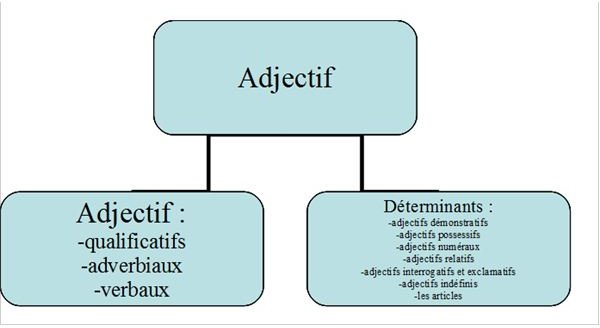Learn about French Adjectives: The Qualifying Adjective
Introduction to the French Adjectives
Adjectives are, generally speaking, a word that describes a person or thing.
For example, in the sentence:
I like this beautiful house.
“beautiful” is an adjective and it describes the noun “house”.
There are however, many different kinds of adjectives in French. Being able to identify and distinguish the various kinds of French adjectives will be an important part of your studies. Why? Simply because it is part of the French grammatical forms and the different kind of adjectives will often be referred to in various explanations of various grammatical rules.
The French adjective is normally separated in two broad categories of adjectives. Look at the diagram below to get a better understanding.
* I have kept the original French terminology. Try to get used to using the words in original French and you will slowly get used to using the original term rather than the translated one.
For the scope of this article, we will limit ourselves to the first category of adjectives and more specifically to the the qualifying adjective, the adverbial adjective and the verbal adjective. Future articles will cover the rest of the varieties of adjectives.
The Qualifying Adjective
L’adjectif qualificatif (qualifying adjective) in French defines people or things with a certain quality.
Generally speaking, the adjectif qualificatif agrees with the noun it defines both in gender and number. For more information about gender in French, read the following excellent article.
Let’s look at the following sentence to better understand this:
J’aime ces belles maisons (fem. plur.).
I like those beautiful houses.
In English, beautiful remains the same, regardless of the noun it defines. In French however, the adjective changes to agree with the noun it defines. In the sentence above, the gender of maisons is feminine and the noun is plural (presence of an “s” at the end of the noun), the adjective is consequently written ‘‘belles’’. Let’s look at a different sentence to get a better idea.
C’est un beau garçon (masc. sing.).
That’s an handsome boy.
In this sentence, the noun garçon is masculine and singular so the adjective has to reflect that, which is why ‘‘beau’’ is used instead of ‘‘belles’’.
The Qualifying Adjective: Exceptions
#1: When numerous singular nouns are defined by the same adjective, the plural form is used.
Le chat et le chien sont noirs.
The cat and the dog are black.
Although taken separately, both chat and chien are singular, they are find themselves “grouped” together as they are defined by the same adjective which is why the plural form is required.
#2: Multiple nouns of different genders define by an adjective
With multiple nouns of different genders (both masculine and feminine) defined by a single adjective, we use the masculine/plural form.
Le frère et la sœur sont fatigués.
Both brother and sister are tired.
Although sœur is feminine, the presence of a masculine noun (frère) takes the upper hand. However, If both nouns’ gender had been feminine, fatigués would have taken the feminine/plural form: fatiguées.
#3 : Words separated by “ou”
“ou” in French, means “or” in English. Adjectives sometimes find themselves separated by “ou”. Once again, let’s look at a sample sentence.
Il est d’une générosité ou d’une naïveté extraordinaire.
He shows generosity or extraordinary naivety.
In this case, the second adjective is excluding the first one, it is one or the other, not both. In this specific case, he is either extremely generous or naïve. When this is the case, the adjective (in this case extraordinaire) agrees with the last noun in the sentence (in this case naïveté).
#4 : Noun and noun complement
With a noun and its complement, the agreement depends on the intended meaning. Let’s look at the sentence below to get a better idea:
Un verre d’eau froid/froide.
This sentence can have two different meaning. Since “verre” is masculine and “water” is feminine, the agreement with the adjective cold (froid/froide) will depend on the meaning of the sentence.
It can either refer to a glass containing cold water (un verre d’eau froide) or a cold glass containing water (un verre d’eau froid).
#5: Collective nouns
When it comes to collective nouns (ex,: groupe for group), the adjective agrees with the collective or its complement. Let’s look at two sentences to better understand this.
La plupart des voyageurs sont malades.
Most of the travelers are sick.
In this case, plupart means “most of”. It is not all of the travelers who are sick, it’s most of them. This is why the adjective malades (sick) agrees with voyageurs (traveler).
Ce groupe de touristes est américain.
This group of tourists is American.
In this sentence, the adjective is agreeing with the group (groupe: masculine/singular) itself, not with the Americans of the group.
#6: Colors
Simple adjectives of color (single word adjectives of color) agree normally in both gender and number.
Une maison (fem.sing) bleue.
A blue house.
Compound adjectives of color (adjectives of color composed of more than one word) remain invariable.
Une voiture (fem.sing) bleu marin.
A marine blue car.
Adjectives made up of nouns also remain invariable.
Des cheveux poivre et sel.
Some salt and pepper hair.
This post is part of the series: French Plural Form
Articles related to the plural form of French words with downloadable review exercises.
